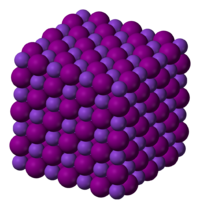
Potassium iodide
Background Information
SOS Children volunteers helped choose articles and made other curriculum material All children available for child sponsorship from SOS Children are looked after in a family home by the charity. Read more...
| Potassium iodide | |
|---|---|
 |
|
 |
|
|
Potassium iodide |
|
|
Other names
Kalium iodide, |
|
| Identifiers | |
| CAS number | 7681-11-0 |
| RTECS number | TT2975000 |
| Properties | |
| Molecular formula | KI |
| Molar mass | 166.00 g/mol |
| Appearance | white crystalline solid |
| Density | 3.13 g/cm3, solid |
| Melting point |
681 °C (954 K) |
| Boiling point |
1330 °C (1603 K) |
| Solubility in water | 128 g/100 ml (6 °C) |
| Hazards | |
| MSDS | External MSDS |
| R-phrases | R36, R38, R42- R43, R61 |
| S-phrases | S26, S36- S37, S39, S45 |
| Main hazards | Slightly hazardous |
| NFPA 704 | |
| Related compounds | |
| Other anions | potassium bromide potassium chloride |
| Other cations | lithium iodide sodium iodide rubidium iodide caesium iodide |
| Except where noted otherwise, data are given for materials in their standard state (at 25 °C, 100 kPa) | |
| Infobox references | |
Potassium iodide is a white crystalline salt with chemical formula KI, used in photography and radiation treatment. It finds widespread application as an iodide source because it is less hygroscopic than sodium iodide, making it easier to work with. KI can turn yellow upon heating in air or upon standing in moist air for long periods, because of oxidation of the iodide to iodine.
Chemical properties
Potassium iodide behaves as a simple ionic salt, K+I−. Since the iodide ion is a mild reducing agent, I− is easily oxidised to I2 by powerful oxidising agents such as chlorine:
Even air will oxidize iodide as evidenced by the observation of a purple extract when KI is rinsed with dichloromethane. Under acidic conditions, KI is oxidised even more easily, due to the formation of hydroiodic acid (HI), which is a powerful reducing agent.
KI forms I3− when combined with elemental iodine.
Unlike I2, I3− salts can be highly water-soluble. I2 and I3− have virtually identical redox potentials (0.535 and 0.536 V vs NHE, respectively), i.e. they are both mild oxidants relative to H2. Therefore, this reaction allows the iodine to be used in aqueous solutions for redox titrations.
Potassium iodide also serves in some organic reactions as a source of iodide ion (see "uses" below).
Physical Properties
It occurs as odourless, colourless, transparent or somewhat opaque crystals or white granular powder. It is slightly hygroscopic, the taste is saline and slightly bitter. On long exposure to air, it becomes yellow due to the liberation of iodine and small quantities of iodate may be formed.
Uses
Potassium iodide is used in photography, in the preparation of silver(I) iodide for high speed photographic film:
Potassium iodide is also added to table salt in small quantities to make it "iodized". In a saturated solution, it is also used as an expectorant to treat lung congestion.
KI is often used as a source of iodide ion in organic synthesis. A useful application is in the preparation of aryl iodides from arenediazonium salts. For example:
Saturated solution of potassium iodide is also used as treatment for sporotrichosis, a fungal infection.
In medical use, it can also serve as an antiseptic for people suffering from sore throat. The dose is 0.5 g-1.0 g in 100 mL, with the accompany of iodine (0.5 g-1.0 g in 100 mL).
KI is also used as a fluorescence quenching agent in biomedical research because of collisional quenching by its iodide ion.
In aqueous solution with elemental iodine, it acts as a gold etchant and will attack and dissolve gold surfaces.
Radiation protection
Potassium iodide may also be used to protect the thyroid from radioactive iodine in the event of an accident or attack at a nuclear power plant, or other nuclear attack, especially where a nuclear reactor is breached and the volatile radionuclides, which contain significant amount of 131I, are released into the environment. Radioiodine is a particularly dangerous radionuclide because the body concentrates it in the thyroid gland. Potassium iodide cannot protect against other causes of radiation poisoning, however, nor can it provide any degree of protection against a dirty bomb unless the bomb happens to contain a significant amount of radioactive iodine. In case of a nuclear emergency, iodine used for the cleaning of wounds should not be ingested. It is a poison.

| Age | KI in mg | KIO3 in mg |
|---|---|---|
| Over 12 years old | 130 | 170 |
| 3 - 12 years old | 65 | 85 |
| 1 - 36 months old | 32 | 42 |
| < 1 month old | 16 | 21 |
In January 2008, John Marburger, the director of the Office of Science and Technology Policy in the United States, stated that potassium iodide pills "offer negligible additional protection" against radiation exposure, and that in the event of a nuclear radiation emergency, efforts would be better spent on evacuation and distribution of safe food.
See fission products and the external links for more details.
Precautions
Mild irritant, wear gloves. Chronic overexposure can have adverse effects on the thyroid.


